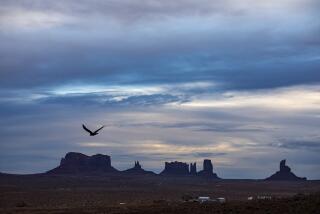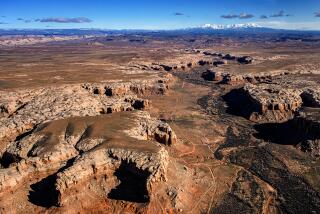Sacred Site Draws Navajos Despite Skeptics
- Share via
BIG MOUNTAIN, Ariz. — By Cadillac and by pickup truck, by tour bus and by motorcycle, the people keep coming, turning off the reservation highway and bumping down 13 miles of rocky dirt road.
Thousands of Navajos have made a pilgrimage to this desert community since May 5, when a 96-year-old woman said she was visited by two tribal gods in the form of old Navajo men.
But even as Navajos flock to the site, sometimes waiting hours for a glimpse of Irene Yazzie’s rundown hogan, there is widespread disagreement about how authentic the visitation was. The debate rages at trading posts and diners, where people eat mutton stew and fry bread under tarps and gossip in the Navajo language.
To some, the visit is a clear message--Navajos are in grave danger if they continue to forsake their traditions. The deities, it is said, warned that drought, poverty and rampant alcoholism on the reservation are all proof of the danger.
But some suspect the story was concocted to scare Navajos to return to their traditions, a tale like that of the white buffalo held sacred by the Plains Indians.
And some suggest the visitation was dreamed up to give the area a sacred aura and thereby boost the Navajos’ claim to the land. The land is at the center of a bitter battle between the Hopi and the Navajo tribes. The grounds were declared Hopi land by Congress in 1974, but about 250 Navajo families still live there.
“If it was really sacred, it should have been closed just to the medicine men,” said Bessie McCabe, a 47-year-old Navajo. She sheepishly admitted visiting the pilgrimage site “mostly out of curiosity.”
The visit has stirred such interest across the 17-million-acre Navajo Nation that the locals have printed maps of the dirt roads and have tied yellow ribbons to mark the way to the desolate spot. Navajo Tribal President Albert Hale even granted tribal employees four hours’ leave to visit the site and declared May 17-24 Spiritual Unity Week.
Hopi Chairman Ferrell Secakuku said the influx of Navajo pilgrims heading for Yazzie’s home could upset the fragile relations between the tribes. “I don’t want her prayers to overshadow the settlement we’ve reached with the Navajo people,” Secakuku said.
The vast Navajo reservation, which reaches into Utah and New Mexico, surrounds the far smaller Hopi lands. There are about 11,000 Hopis and nearly 200,000 Navajos, the nation’s largest Indian tribe.
News of the visitation spread mostly by word of mouth. Yazzie banned cameras and video recorders and demanded that no one discuss the incident with non-Indians. The reservation newspaper, The Navajo Times, agreed not to write of the matter at Yazzie’s request.
The tale told around the reservation is that the deities appeared to Yazzie as old men. Yazzie, unable to talk after suffering a stroke, regained her speech a few days before the gods’ arrival, saying visitors were coming.
Visitors look, pray and sprinkle corn powder, a traditional Indian offering, in the footprints said to have been left by the deities.
More to Read
Sign up for Essential California
The most important California stories and recommendations in your inbox every morning.
You may occasionally receive promotional content from the Los Angeles Times.













